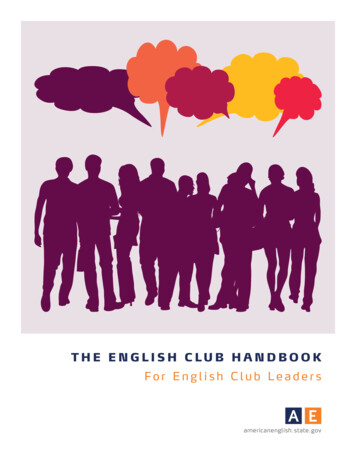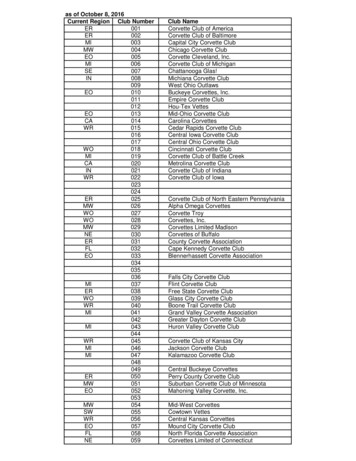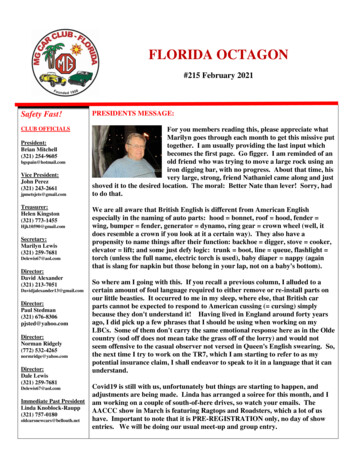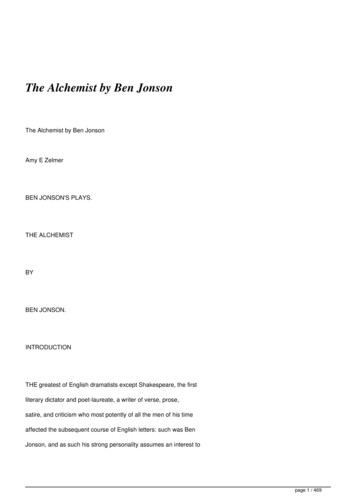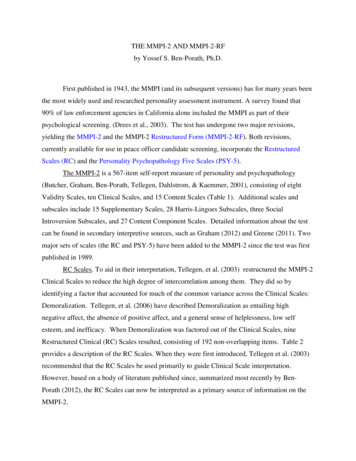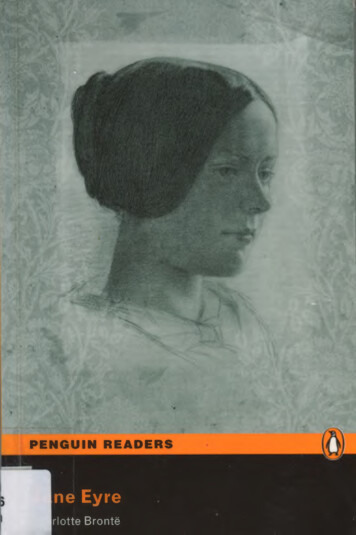
Transcription
PEN G U IN R E A D E R Sn6 Eyrerlotte Bronte
Jane EyreCHARLOTTE BRONTELevel 5Retold by Evelyn AttwoodSeries Editors: Andy Hopkins and Jocelyn Potter
ContentspageIntroductionChapter 1Chapter 2Chapter 3Chapter 4Chapter 5Chapter 6Chapter 7Chapter 8Chapter 9Chapter 10Chapter 11Chapter 12Chapter 13Chapter 14Chapter 15Chapter 16Chapter 17Chapter 18Chapter 19Chapter 20vGatesheadThe Red RoomIllnessMr BrocklehurstA JourneyLowood InstitutionHelen BurnsA Childs ShameMiss TempleDeathA Desire for ChangeThornfieldStrange LaughterMeeting with a StrangerMr RochesterFire!Grace PooleVisitorsAfter 8
Chapter 21Chapter 22Chapter 23Chapter 24Chapter 25Chapter 26Chapter 27Chapter 28Chapter 29Chapter 30Chapter 31Chapter 32Chapter 33Chapter 34Chapter 35Chapter 36Chapter 37Chapter 38Chapter 39Chapter 40Chapter 41Chapter 42Chapter 43Chapter 44ActivitiesThe Fortune-TellerA Cry in the NightDaylightNews from GatesheadMrs Reed’s SecretReturn to ThornfieldThe Storm BreaksThe Torn VeilThe WeddingMr Rochester’s StoryFlightDespairThe Rivers FamilyHopes and DisappointmentsNew ExperiencesThe HeiressRelationsHomecomings‘Jane! Jane! Jane!’A Blackened RuinDeath and DestructionMagicPast and FutureThe 136140142145148151154
IntroductionWhat crime was this, what mystery, that broke out first in fire and thenin blood, in the middle of the night?After Jane Eyre gains a position as governess to Adele Varensat Thornfield Hall, the house of Mr Rochester, she sees thepossibility of happiness for the first time in her life. But the houseis full of unexplained mysteries and dangers —strange laughtercomes from the top floor, and people are mysteriously attacked atnight. Mr Rochester himself appears to be living with a terriblesecret. Must Jane accept that she will never have a real home, andthat love and understanding will never be hers?Jane Eyre is the story of an orphan s struggle to find a placein the world. Jane’s parents died when she was a baby and sheknows little about her family. She is brought up by her cruel,widowed aunt, who has three children of her own. The Reedsare not pleased to have to give Jane a home, and she is treated bythem with less consideration than the servants. Her life is made amisery by her cousin John and by her aunts punishments, and shefinally becomes very ill. After she expresses her great unhappinessto the doctor, she is sent away to a school for orphans. Life is veryhard at Lowood Institution, too, but Jane does at least experiencefriendship and kindness there for the first time.When Jane advertises for a teaching position and takes thejob at Thornfield Hall, it seems that she has at last found herplace in the world. But her suffering is not at an end, and sheeventually finds herself again without money, possessions or ahome. She wants to be valued, to find self-respect and economicindependence, but the world does not expect a small, plain youngwoman with no family support to have ambition. Does nobodycare?v
Charlotte Bronte was born in Yorkshire, England in 1816, thethird child in a family of writers. Their father, Patrick, was anIrishman who became the minister of a church in Haworth in1820. Their mother, Maria Branwell, died in 1821, and her oldersister came to look after the family. Mr Bronte himself educatedBranwell, the only boy of the six children, at home. But theiraunt was not able to deal with the girls’ education and in 1824the two oldest girls, Maria and Elizabeth, were sent away to aschool for clergymens daughters, where Charlotte and Emilyjoined them later. Conditions at the school were difficult andMaria and Elizabeth were taken ill and sent home, where theyboth died in 1825. Charlotte and Emily were then taken awayfrom the school.For the next five years, the four remaining children stayed athome. Branwell received lessons from his father and the girls —Charlotte, Emily and Anne - educated themselves as wellas they could. The children all read widely. They saw little ofother families and, to make their dull life in a small village moreinteresting, they began to make up stories. Many of those storiesstill exist today.In 1831 Charlotte went away to school again, returning ayear later to teach her sisters. She went back to the school as ateacher in 1835 and took Emily with her, but she found teachingdifficult at the school and in the two positions as governess thatfollowed. During this period she had two offers of marriage,which she refused. She was keen to open a school of her own,and in 1842 she went to Belgium with Emily to improve herFrench. When their aunt died, the girls returned home. Charlottethen went back to Brussels by herself but was lonely, became illand returned to Haworth again. Her brother Branwell had failedat every job he tried and increasingly turned to alcohol anddrugs. To add to her unhappiness, Charlotte’s attempts to open aschool in Haworth failed.VI
In 1846, Charlotte persuaded her sisters Emily and Anne toallow their poems to appear in a book with her own poems. Thebook, which they paid for themselves, was not a financial success,but they all continued to write. Charlotte’s novel Jane Eyre cameout first, in 1847, and was an immediate popular success. Laterthe same year, Anne’s Agnes Grey and Emily’s Wuthering Heightsappeared. ( Wuthering Heights, a story of passionate love and equallypassionate hatred, is also a Penguin Reader.)Branwell died in September 1848. At his funeral Emily caughta fever and became very ill. She died in December. Anne diedin May of the following year, at Scarborough, where she hadhoped the sea air would help to improve her health. In spite ofthese terrible events, Charlotte continued with her writing andmanaged to complete two more books. She married a clergyman,A. B. Nicholls, in 1854, but died a year later. Her husbandcontinued to look after Mr Bronte, who lived longer than all hischildren and died at the age of eighty-four.The first novel that Charlotte Bronte wrote, The Professor, didnot actually appear until 1857, after her death. It tells the storyof an English teacher in a school in Brussels, and is based onCharlotte’s own experiences there. Shirley (1849) is set inYorkshire at a time of great industrial changes. It is a romanticstory, but also comments on the lives of women at that time andtells of unrest among the cloth-makers in the area. Villette (1853)is set in Brussels again, in a school for young ladies, where anorphan and outsider —like Jane Eyre —becomes a teacher.Charlotte began writing Jane Eyre, her most famous andpopular work, in a nursing home in Manchester, where herfather was receiving treatment. It is written in the first person,and is the story of a young woman’s struggle to make a lifefor herself while keeping her self-respect and obeying her ownmoral principles, particularly when she falls in love with a man
from a much higher class than herself. Some readers of the timewere shocked that a girl as poor and plain as Jane should havethe right to passionate emotions, but Jane Eyre is a woman whoknows her own mind and is not afraid to express it. These readerswere particularly shocked that the book was written by a woman(although the book originally came out as the work of ‘CurrerBell’, a name that was neither recognisably male nor female, andCharlotte s sisters also used different names to protect themselvesfrom criticism). Most people, though, including Queen Victoria,praised the story, and it has remained popular since that time.Society in nineteenth century England was in many ways verydifferent from today. People were either working class, middleclass or upper class and it was not possible to move from oneclass to another. Men worked and earned the money for theirfamilies. Women still had to obey their fathers, husbands orbrothers. Working-class women could earn money as servants,but these jobs paid poorly so it was very difficult for women tobe independent. Middle-class women could become governessesor teachers, which paid more. There was no National HealthService, so if someone could not pay for a doctor, their chancesof recovery were very limited.England in the nineteenth century offered few opportunitiesto orphans. Lacking family and money, they could not rise frompoverty without the kindness of strangers. They were oftentreated with suspicion and punished severely. Schools for orphansusually spent little on the children s education, clothes, food andcomforts. But there were people who recognized this injusticeand fought for better conditions. Changes were made, as theywere, eventually, to Lowood Institution in this story.Jane Eyre was first made into a silent film in 1910, and again in1914 and 1921. The first film with sound was in 1934. In 1944,Orson Welles played Mr Rochester and Joan Fontaine took thepart of Jane. In 1996 Franco Zeffirelli directed William Hurt and
Charlotte Gainsbourg in his film of this title. Every few years afilm of Jane Eyre is made for television, most recently in 2006.Readers and viewers care about the poor, young governess.Will Jane find her dream of happiness, or will her only hope becruelly destroyed?
Chapter 1 GatesheadThere was no possibility of taking a walk that day. We had, in fact,been wandering in the leafless garden for an hour in themorning, but since dinner the cold winter wind had broughtwith it such dark clouds and such heavy rain that further outdoorexercise was impossible.I was glad of it; I never liked long walks, especially on coldafternoons. I hated coming home with frozen fingers and toes,with a heart saddened by the rough words of Bessie, the nurse,and by the consciousness of how weak I was, compared withEliza, John and Georgiana Reed.Eliza, John and Georgiana were now with their mama in thesitting room at Gateshead. She lay resting by the fireside, andwith her loved ones near her (for the moment neither quarrellingnor crying) she looked perfectly happy. She had dismissed mefrom the group, saying that she was sorry she was forced to keepme at a distance, but that until I tried seriously to develop a morefriendly and attractive nature, she really could not allow me tojoin in the pleasures intended only for happy little children.‘But what have I done?’ I asked.Jane, I don’t like questions or objections. Children should notspeak to those older than themselves in such a way. Sit downsomewhere, and until you can speak pleasantly, remain silent.’A small breakfast room lay next to the sitting room. I slippedin there. It contained bookshelves, and I soon took possession ofa book, making sure that it was one full of pictures. I climbedonto the window seat and, pulling my feet up, I sat cross-legged. Ithen closed the red curtains, so that I was hidden from view.Every picture in the book told a story, often mysterious to myundeveloped understanding, but always deeply interesting - as1
interesting as the stories of love and adventure that Bessiesometimes began on winter evenings, when she happened to bein a good humour.With the book on my knee, I was happy. I feared nothingexcept interruption, and that came too soon. The voice of JohnReed called me. Then there was a silence as he found the roomempty.‘Where in the world is she?’ he cried. ‘Lizzy! Georgy!’ hecalled to his sisters. ‘Jane is not here. Tell Mama she has run outinto the rain. Bad creature!’‘It is lucky that I closed the curtain,’ I thought, and I hopedwith all my heart that he would not discover my hiding place. Hewould not in fact have found it by himself, as he was neithersharp-sighted nor intelligent, but Eliza put her head round thedoor, and said:‘She is in the window seat, surely, John.’I came out immediately, because I trembled at the idea ofbeing dragged out by John.‘What do you want?’ I asked.‘Say, “What do you want, Master Reed?” ’ was the answer. ‘Iwant you to come here.’ Seating himself in an armchair, he madea sign to me to move closer and stand in front of him.John Reed was a schoolboy of fourteen years, four years olderthan I was; he was large and fat for his age, with an unhealthyskin, unattractive features and thick arms and legs. He ought nowto have been at school, but his mama had brought him home fora month or two, “on account of his delicate health”. Hisschoolmaster said that his condition would improve if hereceived fewer cakes and sweets from his family, but his mother’sheart found such a severe opinion unacceptable, and shepreferred to believe that he worked too hard and missed hishome.John was not very fond of his mother and sisters, and he hated2
me. He treated me badly, and punished me, not two or threetimes a week, nor once or twice a day, but continually. I had noprotection from him; the servants did not like to offend theiryoung master, and Mrs Reed never appeared to see him strikeme or to hear him insult me.Having learnt to be obedient to John, I came up to his chair.He spent about three minutes in putting out his tongue at me. Iknew that he would hit me soon, and while I waited fearfully forthe blow, I thought about his disgustingly ugly appearance. Iwonder whether he read my mind in my face; suddenly, withoutspeaking, he struck me sharply and hard. I almost fell, and when Iwas upright again, I stepped back from his chair.‘That is for questioning Mama,’ he said, ‘and for hiding like athief behind curtains, and for the look you had in your eyes twominutes ago, you rat!’I was so used to John Reed’s insults that I never had any ideaof replying to them. My anxiety was about how to receive theblow that would certainly follow.‘What were you doing behind the curtain?’ he asked.‘I was reading.’‘Show me the book.’I returned to the window and brought it in silence.‘You have no right to take our books.You are a poor relation,Mama says. You have no money; your father left you none. Youought to beg, and not live here with gentlemen’s children like us,and eat the same meals as we do, and wea
PENGUIN READERS n6 Eyre rlotte Bronte. Jane Eyre CHARLOTTE BRONTE Level 5 Retold by Evelyn Attwood Series Editors: Andy Hopkins and Jocelyn Potter. Contents page Introduction v Chapter 1 Gateshead 1 Chapter 2 The Red Room 4 Chapter 3 Illness 8 Chapter 4 Mr Brocklehurst 13 Chapter 5 A Journey 16 Chapter 6 Lowood Institution 18 Chapter 7 Helen Burns 24 Chapter 8 A Childs Shame 27
